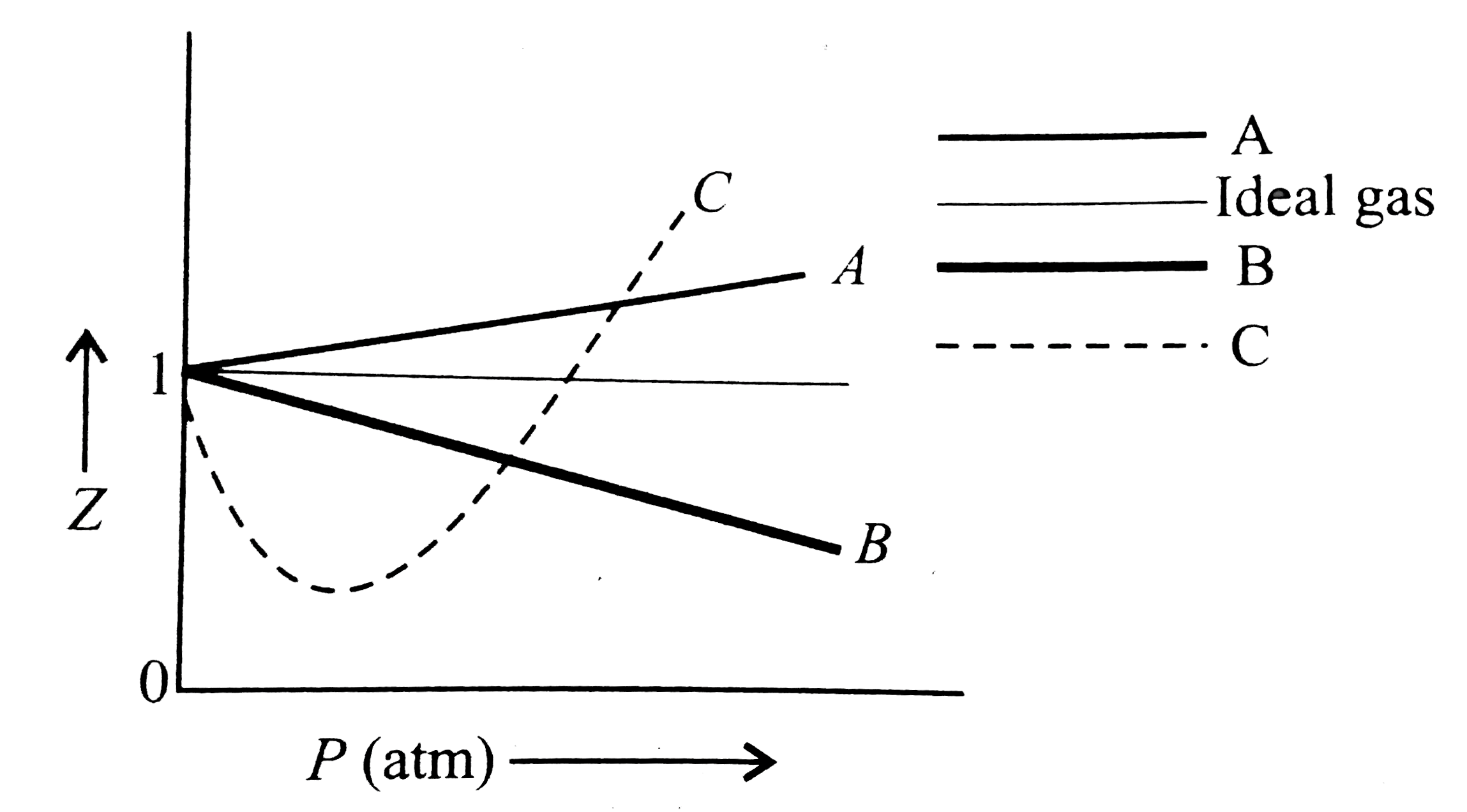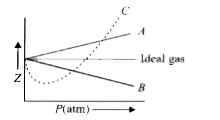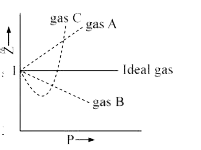The given graph represents the variations of compressibility factor Z=PV/nRT vs P for three real gases A, B, and C.

Identify the incorrect statements.
For gas A, a=0 and its dependence on p is linear at all pressures.
For gas B, b=0 and its dependence on p is linear at all pressures.
For gas C, which is a typical real gas, neither a nor b=0. By knowing the minima and power of intersection with Z=1, a and b can be calculated.
At high pressure, the slope is positive for all real gases.
Compressibility factor,
Z=PVnRT
At high value of pressure, volume occupied by the gas is very small, so b cannot be neglected, but due to a large value of P, a/V2 can be neglected in comparison to P. So, van der Waals equation for 1mol of the gas may be modified as follows:
(P+aV2)(V−b)=RT
aV2<<P
P(V−b)=RT
or PV−Pb=RT
or PV=RT+Pb
∴Z=PVRT=RT+PbRT=1+PbRT
This shows Z>1 and also it should be increasing linearly with pressure.
So, statement (b) should be false.
The value of Z generally increase with pressure and decreases with temperature. At higher pressures, molecules clooide more often, and at lower temperatures, they move less rapidly. This allows attractive forces between molecules to have a noticeable effect, making the volume of the real gas less than the volume of an ideal gas which causes Z to drop below 1. When pressures are lower or temperatures are higher, the molecules are more free to move. In this case, the repulsive forces dominate, making Z>1.
Topper's Solved these Questions
- STATES OF MATTERBook:CENGAGE CHEMISTRYChapter:STATES OF MATTERExercise:Archives (Single Correct)
Explore 32 Videos
- STATES OF MATTERBook:CENGAGE CHEMISTRYChapter:STATES OF MATTERExercise:Archives ( Assertion-Reasoning)
Explore 2 Videos
- STATES OF MATTERBook:CENGAGE CHEMISTRYChapter:STATES OF MATTERExercise:Exercises (Integer)
Explore 10 Videos
- SOME BASIC CONCEPTS AND MOLE CONCEPTBook:CENGAGE CHEMISTRYChapter:SOME BASIC CONCEPTS AND MOLE CONCEPTExercise:Archives Subjective
Explore 11 Videos
- STOICHIOMETRYBook:CENGAGE CHEMISTRYChapter:STOICHIOMETRYExercise:Archives Subjective
Explore 33 Videos
Similar Questions
Knowledge Check
The given graph represents the variation of Z (compressibility factor =PVnRT) versus P, for three real gases A,B and C. Identify the only incorrect statement.
 AFor the gas A,a=0 and its dependence on P is linear at all pressuresBFor the gas B, b=0 and its dependence on P is linear at all pressures.CFor the gas C, which is typical real gas for which neither a=0 nor b=0. By knowing the minima and the point of intersection, with Z=1, a and b can be calculated.DAt high pressure, the slope is positive for all real gases.
AFor the gas A,a=0 and its dependence on P is linear at all pressuresBFor the gas B, b=0 and its dependence on P is linear at all pressures.CFor the gas C, which is typical real gas for which neither a=0 nor b=0. By knowing the minima and the point of intersection, with Z=1, a and b can be calculated.DAt high pressure, the slope is positive for all real gases.The given graph represents the variation of Z (compressibility factor =PVnRT) versus P, for three real gases A, B and C. Identify the only incorrect statement.
 AFor the gas A, a=0 and its dependence on P is linear at all pressures.BFor the gas B, b= 0 and its dependence on P is linear at all pressures.CC is less compressible than expected from ideal behaviour.DAt high pressure, the slope is positive for all real gases.
AFor the gas A, a=0 and its dependence on P is linear at all pressures.BFor the gas B, b= 0 and its dependence on P is linear at all pressures.CC is less compressible than expected from ideal behaviour.DAt high pressure, the slope is positive for all real gases.For H2 gas, the compressibility factor,Z = PV /n RT is -
AEqual to 1BEqual to 0CAlways greater than 1DInitially less than 1 and then becomes greater than 1 at high pressures
The compressibility factor Z=(PVnRT) of a gas above T=aRb will be :
View SolutionWhich of the following represents a plot of compressibility factor (Z) versus P at room temperature for helium?
View SolutionCompressibility factor of a gas is given by the equation Z=PVnRT. On this basis , mark the correct statement.
View SolutionConsider the given plot of enthalpy of the following reaction between A and B. A+B→C+D. Identify the incorrect statements

View SolutionCompressibility factor of a gas is given by the equation Z=PVnRT. On this basis , mark the correct statement.
View Solution
